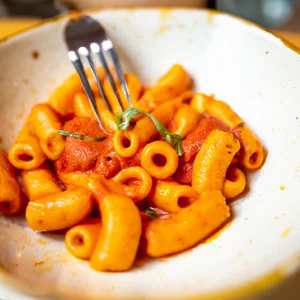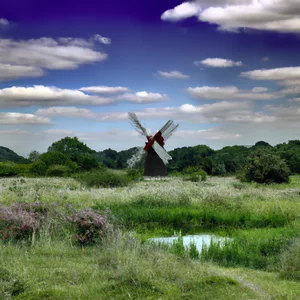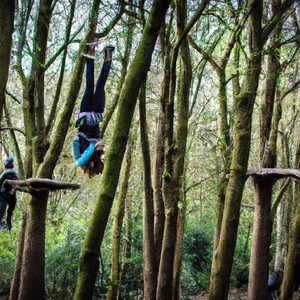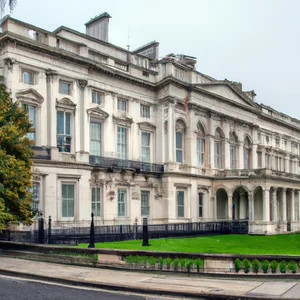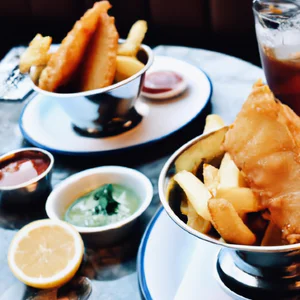Book your experience
Curry on Brick Lane: culinary journey through London's East End
So, let’s talk a little about the wonder that is curry on Brick Lane, a real journey into the heart of London’s East End. Maybe it’s because, when I went there for the first time, it felt like I was walking into a movie: the lights, the colors, and that scent of spices that envelops you like a warm blanket on a winter evening.
I’m serious, it’s like every restaurant has its own story to tell, with those menus that are miles long. I mean, have you ever tried to choose between a plate of tikka masala and a steaming biryani? It’s quite a feat! And let’s not even talk about the street vendors, who offer you hot samosas as if they were humanity’s lost treasure.
Once, while enjoying a curry with a friend, I noticed a guy dancing in the middle of the street. I don’t know if he had drunk a little too much or if he was simply taken by the magic of the place, but that moment made me realize how alive and vibrant this area is. Sometimes, I think that Brick Lane is not just a place to eat, but almost a sort of mystical experience, where you get lost in the flavors and stories of the people.
And then, speaking of curry, I cannot fail to mention the different variations. There are those who say that the best is the spicy one, which makes you sweat a little and makes you feel alive, while others prefer something sweeter and creamier. Maybe I have a weakness for spicy, but in the end, all tastes are tastes, right?
However, if you’re in the London area and don’t pop into Brick Lane, well, you’re missing out on a golden opportunity. It’s a bit like not enjoying a good ice cream in summer, madness, in short! And who knows, maybe one day I’ll go back and let myself be carried away again by that mix of flavours, colors and vibrations. What can I say, I can’t wait!
Discover the secrets of authentic Indian curry
A sensorial journey through spices and flavors
The first time I stepped into one of the curry restaurants on Brick Lane, I was struck by the vibrant air and enveloping scents that mingled in a warm embrace. An indelible memory is linked to a small family-run restaurant, where the owner, an elderly chef, welcomed me with a smile and a generous portion of biryani. As I savored that rich, aromatic dish, I realized that curry is not just a meal, but an experience that tells stories of tradition, culture and passion.
The secrets of real Indian curries
Authentic Indian curry is a symphony of flavors and aromas, and each dish is the result of a unique story. In Brick Lane, the Bengali community brought with them recipes passed down from generation to generation. The secret lies in using fresh, high-quality spices. Ingredients like cumin, coriander, turmeric and cardamom not only add flavor but also create an olfactory experience that transports you to the markets of Kolkata. According to the “Curry Club” of London, to achieve a truly authentic curry, it is essential to toast the spices in a pan before adding them to dishes, a step often overlooked in Western restaurants.
Insider tips
A tip that few know is not to limit yourself to ordering the most famous dishes such as tikka masala or vindaloo. Instead, try local specialties such as “bhuna” or “phaal”, dishes that tell the true essence of Bengali cuisine. Also, try to visit restaurants during less crowded hours; you’ll have the chance to chat with the owners and learn fascinating details about their dishes and culture.
A profound cultural impact
Curry has had a significant impact on the cultural identity of London’s East End. This area has become a melting pot of cultures, where Indian cuisine is an integral part of daily life. The arrival of Bangladeshi migrants in the 1970s transformed Brick Lane into a gastronomic destination, and today curry is synonymous with conviviality and celebration.
Sustainability and responsibility
When exploring curry restaurants, try to choose those that use fresh, local ingredients. Some restaurants, like Dishoom, are committed to sustainable practices, such as reclaiming unused ingredients and sourcing produce from local suppliers. Supporting these activities not only promotes sustainability, but also enriches the dining experience.
An experience worth trying
For an authentic experience, don’t miss the opportunity to attend a cooking workshop in a local home. Here, you can learn how to prepare your own curry, discovering the secrets of spices and cooking techniques. This activity will not only enrich your cooking skills but also allow you to connect with Bengali culture in a unique way.
Myths and misconceptions
A common misconception is that curry should always be spicy. In reality, curry can be sweet, spicy or aromatic, depending on the spices and ingredients used. Each dish has its own personality, and what matters is the quality and balance of flavors.
Final reflection
After tasting the richness of the curry on Brick Lane, I wonder: how many stories are hidden behind each dish we taste? Considering food as a means to connect with different cultures enriches every travel experience. Next time you are in London, don’t forget to be amazed by the magic of authentic Indian curry.
Brick Lane: beating heart of Bengali culture
A personal experience
I still remember the enveloping scent of spices wafting through the air as I walked along Brick Lane for the first time. It was a Saturday afternoon and the market was in full swing; the children’s laughter mixed with the calls of the vendors. I stopped at a small kiosk run by a Bengali family, where I tasted a freshly fried samosa accompanied by a fresh mint sauce. That simple experience marked the beginning of my passion for Bengali cuisine and, in particular, authentic Indian curry.
Practical information
Brick Lane is not just a place to visit, but a living cultural experience. Every year, thousands of visitors flock to this historic street in the heart of London’s East End, attracted by its unique restaurants and shops. Among the most renowned restaurants, Dishoom offers a modern interpretation of traditional Indian dishes, while Aladin is famous for its spicy biryani. For those looking for an authentic experience, the Curry Capital of Britain is easily accessible by tube: getting off at the Whitechapel stop is the first step on an unforgettable culinary journey.
An insider tip
If you want a taste of curry as Bengali families prepare it, look for the lesser-known curry houses, which are not found on the tourist circuit. These restaurants often offer daily specials, prepared with fresh ingredients and recipes passed down from generation to generation. Don’t be afraid to ask the staff what their recommendations are; they often know the most authentic and tasty dishes.
The cultural impact
For decades, Brick Lane has become a symbol of the Bangladeshi community in London. Its evolution from an industrial area to a cultural center lives on through the restaurants, markets and festivals that celebrate Bangladeshi culture. Here, curry is not just a dish, but a link between past and present, a way to keep culinary tradition alive in an increasingly globalized context.
Sustainability and responsibility
When exploring Brick Lane, it’s important to choose restaurants that practice sustainable methods. Many local restaurants support local spice makers and use organic ingredients. Be careful of restaurants that highlight a short supply chain and are committed to reducing the own environmental impact.
An activity worth trying
For a truly unique experience, take a cooking class at one of the local cooking schools. Here you can learn the secrets of authentic Indian curry directly from expert Bengali chefs and take home traditional recipes to replicate in your own kitchen.
Myths and misconceptions
A common misconception is that Indian curry is only ever spicy. In reality, Bengali cuisine is a harmony of flavours, aromas and textures, and spiciness is just one of many elements. The true essence of curry lies in the combination of spices such as turmeric, cumin and coriander, which create a rich and complex flavor profile.
Final reflections
Next time you’re in Brick Lane, ask yourself: what’s your favorite curry dish and how does it tell your story? Cooking is a journey, and every bite of curry brings you closer to understanding the soul of a vibrant and fascinating culture.
The best curry restaurants you can’t miss
An unforgettable experience
I still remember the first time I set foot in one of the curry restaurants on Brick Lane, surrounded by the intense scent of spices and the warmth of a sincere welcome. As I sat at the table, the waiter served me a plate of chicken biryani, the golden, fragrant grains of rice dancing on my fork. Every bite told a story of tradition and passion, an experience I could never forget. Brick Lane, with its vibrant Bengali culture, is the ideal place to discover not only curry, but also the soul of a community.
Restaurants not to be missed
When talking about curry in London, it’s impossible not to mention some of the most iconic restaurants:
- Dishoom: Inspired by Indian cafes, here you can enjoy a smoked biryani and a chicken ruby in an atmosphere reminiscent of 1960s Bombay.
- Aladin: This restaurant is famous for its lamb curry, prepared with a recipe passed down for generations. Don’t forget to try their hot naan, perfect to accompany the dishes.
- Lal Qila: A real gem, where the butter chicken is a must and the generous portions will make you feel at home.
An insider tip
A little-known tip is to ask the waiter to recommend the dishes of the day, which are often not listed on the menu. At many Brick Lane restaurants, the chefs love to experiment and you might discover a new dish you never thought of trying!
The cultural impact
The presence of Indian and Bangladeshi restaurants in Brick Lane is not just about the food, it is a cultural meeting point that celebrates the heritage of the Bangladeshi community in the UK. In the 1970s, this area saw an incredible growth in Indian restaurants, which established themselves as symbols of welcome and integration.
Sustainability and responsibility
When choosing a restaurant, consider visiting those that use local ingredients and sustainable practices. Many restaurants in Brick Lane are committed to reducing their environmental impact, choosing ethical suppliers and fresh ingredients.
Soak up the atmosphere
Imagine sitting in one of these restaurants, surrounded by a lively atmosphere, with the bright colors of the decorations and the sound of rickshaw horns in the distance. Each dish is a celebration of Indian flavours, and the human warmth of the restaurateurs makes the experience even more special.
An unmissable activity
After enjoying a delicious curry, I recommend strolling along Brick Lane and visiting the spice markets. Here, you can buy fresh spices and discover the secrets to recreating your own curry at home.
Myths and misconceptions
A common misconception is that all Indian restaurants offer the same type of curry. In reality, Indian cuisine is incredibly varied and each restaurant has its own specialties, often influenced by the owners’ region of origin.
A final reflection
Eating curry on Brick Lane isn’t just a meal, it’s an experience that connects you with a rich and fascinating history. What is your favorite curry dish and what history does it bring with it? We invite you to explore and discover your own personal slice of culinary paradise.
A trip to the historic spice markets
When I first found myself in Spitalfields market, the scent of spices enveloped me like a warm and welcoming hug. It was a sunny Saturday morning, and the market was pulsating with life. Colorful stalls displayed bags of golden turmeric, deep red chilli and aromatic cumin, each promising a sensory journey into the secrets of Indian cuisine. This is just the beginning of an adventure that transcends simple shopping: it’s an immersion in the culture and history of a place that has seen generations of traders and food lovers.
The markets not to be missed
London’s historic spice markets, such as Borough Market and the aforementioned Spitalfields, are more than just places to buy ingredients. Every corner tells stories of ancient trade routes and cultural interactions. Here you can find rare spices from every corner of India, often sold by vendors carrying on family traditions. Borough Market, for example, offers an incredible selection of fresh spices, where you can also watch cooking demonstrations and enjoy freshly prepared dishes.
For those who want a more authentic experience, I recommend visiting Brick Lane, where spices mix with art and history. This is the beating heart of Bengali culture and offers a wide variety of spices and fresh ingredients, often at very competitive prices.
Insider tip
A little-known tip is to look for the small shops hidden behind the busiest stalls. These less visible corners often offer fresher, more authentic spices because vendors have less turnover and care about quality. Also, don’t forget to ask the sellers for recommendations - many of them are happy to share recipes and tips for making the best use of the spices.
Cultural and historical impact
The spice tradition has a profound impact on the culinary culture of London’s East End. The markets have served as a crossroads for different cultures, uniting communities of Indian, Bangladeshi and Pakistani origin in making curry an icon of British gastronomy. This exchange has not only enriched the local cuisine, but also created a link between different culinary traditions.
Responsible tourism
When visiting these markets, it is important to consider sustainable tourism practices. Choosing to buy from local vendors and supporting small businesses helps keep culinary traditions alive and promote a healthy local economy. Additionally, many sellers are committed to using organic ingredients and reducing environmental impact.
An experience worth trying
During your visit, don’t miss the opportunity to attend a cooking workshop at one of the markets. Many chefs offer hands-on courses where you can learn to prepare traditional Indian dishes using the spices you just purchased. It’s a great way to deepen your knowledge and appreciation of Indian cuisine.
Myths and misconceptions
A common misconception is that curry is a single, simple dish. In reality, curry is a generic term that encompasses a variety of dishes and flavors, each with its own history and preparation techniques. Each region of India has its own peculiarities, and discovering these differences is part of the fun.
Final reflection
As you stroll through the spice stalls, ask yourself: what story could tell us about a spice you choose today? The beauty of historic markets lies not only in their aromas and colors, but in the stories that each ingredient brings with it. What secrets of authentic Indian curry will you discover today?
Curry and street food: an experience not to be missed
A journey through the flavors of Brick Lane
The first time I set foot in Brick Lane, the air was thick with extraordinary scents: spices, fried foods and sweets that danced in the vibrant atmosphere of this corner of London. I remember tasting an aloo chaat, a street food dish made with spiced potatoes, served in a paper parcel. Each bite was an explosion of flavors that told stories of intertwining culinary traditions and cultures. It was an experience that transformed my way of seeing curry: not just a restaurant dish, but a real sensorial journey to experience on the street.
The beating heart of street food
The street food in Brick Lane is much more than just a snack; it is an experience that reflects the rich cultural heritage of the area. Street vendors offer a wide range of dishes, from biryani to paneer tikka to desserts such as gulab jamun. According to the local site “Brick Lane Food Tours”, weekends see a veritable crowd of street food enthusiasts flocking to the streets, ready to discover the latest gastronomic innovations.
An insider tip
If you want an authentic experience, try stopping by one of the tented curry vendors in the markets. Many of them offer dishes that you won’t find in more popular restaurants. A little trick is to always ask to taste first: sellers will often be happy to offer you a spoonful of curry or chutney to let you decide. This will allow you to explore unique flavors, such as traditionally prepared chicken tikka masala, which vary from day to day.
A cultural impact
Street food plays a fundamental role in the Brick Lane community, not only as a source of nutrition, but also as a means of connecting people. The history of curry in the East End is not just linked to restaurants, but extends to the markets and stalls which have been an important form of livelihood for many immigrant families. Today, the food scene celebrates this cultural richness, creating an atmosphere where food becomes a bridge between generations.
Sustainability and responsibility
In an age where sustainability is key, many street food vendors on Brick Lane are adopting responsible practices. Many use fresh, local ingredients, reducing the environmental impact of food transportation. By choosing to eat from these stalls, you are not only supporting small local businesses, but also contributing to a more sustainable food culture.
An experience worth trying
If you’re up for a culinary adventure, I recommend joining a street food tour. There are various options available, such as the “Taste of Brick Lane”, which will lead you to discover the secrets of the best curry dishes and street food. You will be guided by experts who share anecdotes and curiosities, making your trip even more memorable.
Dispelling the myths
A common misconception about curry is that it must always be spicy. In reality, Indian curry offers a wide range of flavors, from the most delicate to the most intense. Don’t be afraid to experiment: you may discover dishes that will amaze you with their complexity and goodness.
Final reflection
After enjoying street curry on Brick Lane, I wondered: How can a simple dish unite cultures and people in such profound ways? The next time you find yourself in a crowded market, take a moment to appreciate not only the food, but also the stories and traditions it represents. The beauty of curry, and street food in general, is precisely this: a universal language that speaks of community, history and passion.
History and tradition of curry in the East End
When I first stepped into Brick Lane, the enveloping scent of spices hit me like a warm hug. As I strolled among the stalls and restaurants, an old Indian chef told me the history of curry in London’s East End. He talked to me about how curry is more than just a dish; it is a symbol of cultural integration and resistance. It’s not just a recipe; it is the testimony of centuries of migrations, exchanges and intertwining traditions.
The historical roots
Curry has found a home in the East End since the 1970s, when the Bengali community began to settle in the area. Restaurants, initially small and family-run, began to flourish, bringing with them authentic recipes and a food culture that was previously virtually unknown to Londoners. Today, the East End is a vibrant mosaic of cultures, where curry has become a key element of everyday life.
An insider tip
If you want to discover a lesser-known side of curry, visit one of the many historic cafés, such as Brick Lane Beigel Bake, open 24 hours a day. Here, in addition to the famous bagels, you can savor a beef curry that has roots in Jewish tradition. It is a perfect example of how different cultures can blend into a unique and delicious dish.
The cultural impact
Curry is not just a food; it is a vehicle of stories and traditions. In an age where multiculturalism is under scrutiny, curry is a symbol of unity and celebration of diversity. Every bite tells a story of migration, hope and resilience. The curry festivals, held regularly in Brick Lane, are a tribute to this rich cultural heritage, attracting visitors from all over the world.
Sustainable tourism practices
By visiting restaurants that use local, sustainable ingredients, you are not only supporting the community, but also helping to preserve culinary traditions. Many Brick Lane restaurants work with local producers to ensure freshness and quality, reducing environmental impact. Before ordering, always ask where your food comes from; the staff will be happy to share the story behind each dish.
An experience not to be missed
To fully immerse yourself in curry culture, join a cooking class at one of the local restaurants. You’ll learn not only how to make an authentic curry, but also understand the traditional spices and methods that make it so special. It’s a way to connect with the community and bring a piece of this culture home.
Exposing the myths
A common misconception is that Indian curry is always spicy. In reality, the level of spiciness varies greatly depending on the region and recipe. Many traditional curry dishes are rich in flavor without necessarily being spicy. Always ask your waiter to recommend dishes suited to your palate.
A final reflection
As you savor a delicious curry sitting in one of the restaurants on Brick Lane, ask yourself: how can a simple dish encapsulate the life stories, hopes and dreams of entire generations? The next time you enjoy a curry, remember that you are tasting much more than a meal; you’re exploring a piece of London’s history and culture.
Sustainability: how to choose responsible restaurants
An eye-opening personal experience
The first time I visited Brick Lane, I found myself strolling among the enveloping scents of spices, when a small family-run restaurant caught my attention. The owner, an elderly gentleman with an infectious smile, told me how his restaurant uses only fresh, local ingredients. This choice not only preserves the quality of the food, but also supports community producers. It was an eye-opening moment that made my dining experience not only delicious, but also ethically satisfying.
How to choose responsible restaurants
When looking for a curry restaurant in Brick Lane, it is essential to pay attention to several aspects that can indicate a sustainable approach. Some tips include:
- Check certifications: Look for restaurants with organic certifications or that are part of local sourcing networks.
- Prefer family-run places: These restaurants tend to be more attentive to the quality of ingredients and sustainability.
- Inquire about suppliers: Don’t hesitate to ask where the ingredients are sourced. A responsible restaurant will be proud to share this information.
An insider tip
A little-known trick for finding sustainable restaurants is to check reviews on local platforms, such as Time Out London or Eater London. These sources often highlight places that not only offer excellent food, but are also committed to operating responsibly. Furthermore, some restaurants offer discounts for those arriving by bicycle or on foot, encouraging more eco-friendly forms of transport.
The cultural impact of curry
The curry tradition has deep roots in the cultural fabric of London, and particularly the East End. The fusion of different cultures has led to a variety of curry variations, each with their own influences. Choosing to eat in responsible restaurants is not just a question of food; it’s a way to support and preserve these culinary traditions.
Sustainable tourism practices
Many Brick Lane restaurants are adopting sustainable practices, such as reducing wasted food and using compostable packaging. When choosing a restaurant, also consider ordering shared plates, which not only reduce waste but also offer a richer and more social dining experience.
An activity worth trying
For a truly immersive experience, join a “cooking class” at one of the local restaurants. Not only will you have the opportunity to learn how to cook an authentic Indian curry, but you will also discover the importance of fresh, sustainable ingredients, straight from the hands of those who prepare it every day.
Myths to dispel
A common myth is that all curry restaurants are the same in terms of quality and sourcing. In reality, there are huge differences between the various venues. Choosing a responsible restaurant also means contributing to a community that values quality and sustainability.
A final reflection
Next time you’re on Brick Lane, ask yourself: How can I contribute to a more responsible dining culture? Every choice we make, from the restaurant to the dish we order, can have a significant impact. Choosing restaurants that embrace sustainability not only enriches your dining experience, but also supports a vibrant and resilient community.
A guided tour of the hidden kitchens of Brick Lane
Strolling along Brick Lane, I found myself enjoying a curry that seemed to encompass the entire Indian subcontinent in one dish. It was a small restaurant, almost invisible among the bright lights and bustling tourists. Here, I had the opportunity to hear the story of Anjali, a cook who brought her grandmother’s recipes with her straight from India. She told me that every spice, every ingredient has its own story and that the secret of an unforgettable curry lies not only in the perfect combination, but also in the love and passion with which it is prepared.
The wealth of Brick Lane
Brick Lane isn’t just a street, it’s a mosaic of intertwining cultures, and curry is the common language that unites everyone. The restaurants here offer much more than just a meal; they are places where culinary traditions are handed down from generation to generation. In a recent Guardian article, it was highlighted how the Bengali community has transformed this street into a gastronomic epicenter, keeping traditional recipes alive while embracing new influences.
An insider tip
If you want an authentic experience, look for those small restaurants that don’t have flashy signs. Here, food is not just a meal: it is a journey through time and culture. A little-known tip? Order bhuna, a curry that is slowly cooked to a thick, flavorful consistency. It is not always present on tourist menus, but it is a real treasure for those seeking authentic taste.
A profound cultural impact
Curry has a long history in London’s East End, where it has found a welcoming home among immigrant communities. This dish is not just a food, but a symbol of identity and resistance. The hidden kitchens of Brick Lane tell stories of families who left their homeland, but brought their culinary traditions with them, transforming the street into a place of cultural celebration.
Sustainability in kitchens
Many Brick Lane restaurateurs are committing to sustainable tourism practices. Choosing restaurants that use local, seasonal ingredients not only supports the local economy, but also reduces environmental impact. Find out which restaurants follow these practices and contribute to responsible tourism.
The atmosphere of Brick Lane
Imagine sitting in a busy restaurant, the scent of curries mixing with the cool evening air. Laughter and conversations intertwine, while colored lights dance on the walls, creating a lively and welcoming atmosphere. It’s a place where every bite tells a story, and every dish is a work of art.
An activity worth trying
For an unforgettable experience, book a guided food tour that will take you to discover the hidden cuisines and secrets of local restaurateurs. Not only will you savor delicious dishes, but you will also have the opportunity to learn about the faces and stories behind these culinary delights.
Myths and misconceptions
A common misconception is that Indian curry is always spicy. In reality, curry variations can be sweet, spicy or even fruity, depending on the regions and traditions. Don’t be afraid to ask restaurateurs to recommend a dish that suits your palate.
A final reflection
As you leave Brick Lane, we invite you to reflect: what does curry mean to you? Is it just a dish to be enjoyed or does it represent a deeper connection with distant cultures and histories? Every time you taste a curry, you have the opportunity to travel through time and space, embracing a world of flavors and traditions.
Cultural events: Brick Lane curry festival
When I think of Brick Lane, my mind fills with flavors and colors, but also with events that celebrate the vibrant culture of the Bengali community. My first experience at the Curry Festival was unforgettable: an ode to the dish that made Brick Lane famous around the world. Imagine an entire weekend dedicated to curry, with stalls offering everything from classics like tikka masala to bolder, spicier dishes, prepared by chefs carrying on family traditions.
An experience not to be missed
These festivals, usually held in autumn, not only offer the opportunity to enjoy a variety of authentic curries, but also to immerse yourself in the local culture. The events are accompanied by live music, traditional dances and even cooking workshops. It’s a fantastic way to meet locals and better understand the history of this iconic dish. If you’re in London during the festival, don’t miss the chance to take part - it’s like a foodie journey without having to leave the city!
A insider tip
A little secret I discovered is that during the festival there are always some lesser-known stands offering unique dishes, far from the classics. Look for those run by families, they are often the ones that offer an authenticity and passion that you won’t find in the more advertised restaurants. Don’t be afraid to ask chefs for recommendations; their joy in sharing recipes and the stories behind their dishes is contagious!
The cultural impact of curry
Curry is not just a dish; it is a symbol of the Bengali diaspora and its integration into British culture. Brick Lane has, over the years, become an epicenter of Indian and Bangladeshi cuisine, reflecting a journey of migration that has brought flavors and traditions from one continent to another. During the celebrations, there is a strong sense of community and cultural pride that makes every bite of curry even more special.
Responsible tourism practices
Participating in events like the Curry Festival is also a way to support local restaurateurs and artisans. Many of these events are committed to promoting sustainable practices, such as using organic ingredients and reducing waste. By choosing to participate, you not only get a taste of local culture, but you also contribute to more ethical and responsible tourism.
An invitation to discovery
If you have never had the opportunity to enjoy curry in such a rich cultural context, now is the time to do so. Imagine enjoying a plate of curry surrounded by music and laughter, with the smell of fresh spices filling the air. I invite you to reflect: what dish has ever made you feel so connected to a culture different from your own? Brick Lane and its curry festivals could be that answer.
Savor curry with a local family
An unforgettable experience
I still remember the intense scent of spices that enveloped me as soon as I crossed the threshold of Aditi’s house, a Bengali mother from London. It was a spring evening, the bright colors of traditional clothes mixed with the scents of food wafting from the kitchen. Aditi welcomed me with a warm smile and a plate of freshly fried samosas, but the real star of the evening was the curry that she would prepare together with her family. An experience that goes beyond a simple lunch: it is an immersion in the culture, traditions and stories that each dish tells.
Practical information
Attending a meal with a local family is not only a way to enjoy authentic Indian curry, but also to learn the secrets of family recipes. Several platforms, such as EatWith and Airbnb Experiences, offer the possibility of booking dinners with local families in London. Aditi, for example, offers an evening of cooking and conviviality in her apartment on Brick Lane, where you can immerse yourself in Bengali culinary traditions.
An insider tip
One trick Aditi revealed to me is the importance of letting the curry rest after cooking. This allows the flavors to blend and develop further, making the dish even tastier. A tip that many restaurants don’t mention, but which makes the difference!
The cultural impact
Curry is not just a dish; it is a symbol of conviviality and sharing. In Bengali culture, the meal is a sacred time, an opportunity to bring family and friends together. Sharing a homemade curry is a gesture of affection that transcends simple gastronomic needs. Every bite tells stories of migration, cultural fusions and family memories.
Sustainable tourism
Opting for culinary experiences with local families is also a responsible tourism choice. By supporting the local community, you help preserve culinary traditions and ensure families can continue to share their culture. Additionally, many of these families use fresh, local ingredients, reducing their environmental impact.
Soak up the atmosphere
Imagine sitting around a table overlooking the colorful murals of Brick Lane, while Aditi tells you stories from her childhood in Bangladesh and teaches you how to make the perfect roti. Every bite is a journey through flavors and stories, a moment of authentic human connection.
Activities to try
Don’t miss the chance to participate in a cooking session with a local family. In addition to learning how to prepare curry, you can also discover how to make typical desserts, such as gulab jamun, and learn how to serve a complete meal according to Bengali traditions.
Myths and misconceptions
Many think that Indian curry is always spicy and one-dimensional. In fact, there is a wide range of curries, each with their own ingredients and spice levels. It is a journey of exploration of flavors and aromas, where each dish can reveal something new and surprising.
A personal reflection
After that unforgettable evening with Aditi and her family, I realized that the true meaning of curry goes beyond food: it’s a way to connect with people and their stories. Have you ever wondered what stories hide behind the dishes you taste? Savoring a curry with a local family is more than just a meal; it is an experience that enriches the heart and mind.

 Architecture and Design
Architecture and Design Cities and Regions
Cities and Regions Culture and History
Culture and History Events and Festivals
Events and Festivals Fashion and Shopping
Fashion and Shopping Food and Wine
Food and Wine Nature and Adventure
Nature and Adventure Unique Experiences
Unique Experiences


















